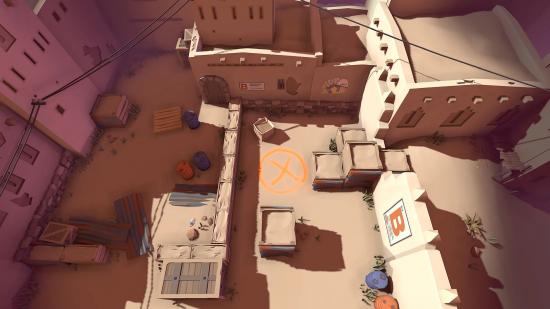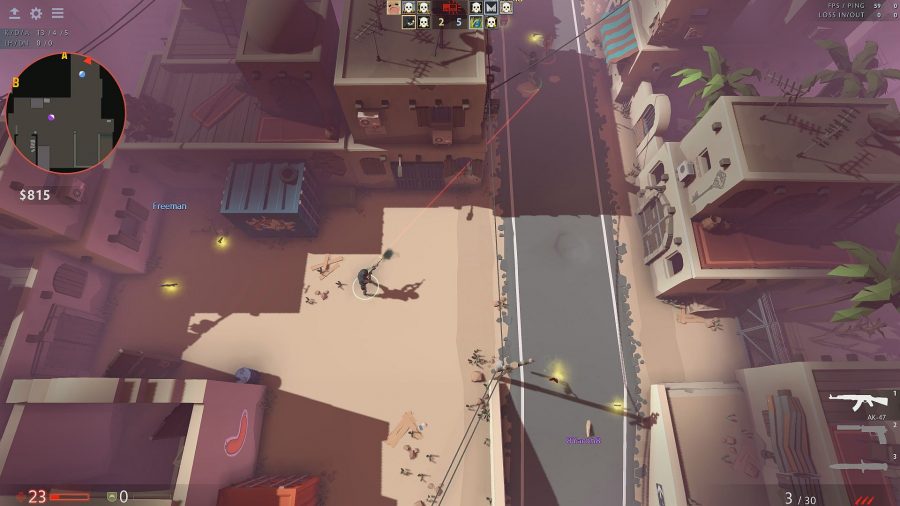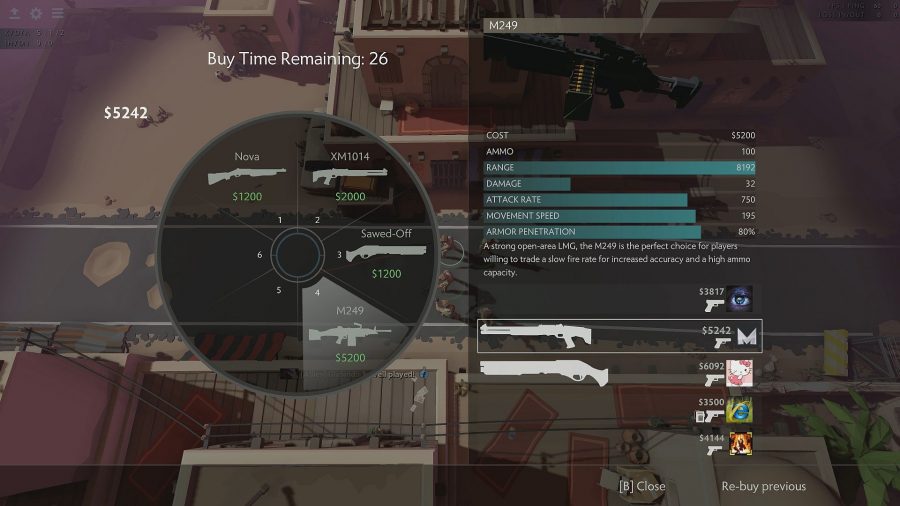By day Markiyan Mocherad is a developer at Ukranian studio FragLab, working on an FPS with Wargaming. But over the past three years he has been making PolyStrike, arguably the most ambitious Dota custom game ever created, in his spare time.
Chances are you’ve seen the gameplay trailer (below) after it blew up the other week, but if you missed it, PolyStrike is, quite simply, CS:GO in a top-down perspective. Built in Source 2 via Dota 2’s custom game tools, all the weapons from Counter-Strike are present, as well as grenades and all the other good stuff. The iconic dust2 map has been recreated – it looks brilliant from above – and the UI is pretty much identical to that of CS:GO. If you didn’t know this was all happening inside Dota 2, you’d probably think it was an entirely separate game.
The Dota 2 custom engine isn’t known for things such as this. The biggest success to come from it – Auto Chess – created a new way to play but still used Dota 2 mechanics and assets, which is the case for most custom games. PolyStrike takes things to another level, using no visual assets from Dota and instead relying (mostly) on custom art.
“I could have coded PolyStrike in Unreal [Engine], Unity or Lumberyard, but since Valve owns the rights to Counter-Strike, remaking it in Dota was my only option,” says Mocherad. “With the first alpha gameplay, I was using some particles and dropped item models, but now I can say that I don’t use any 2D or 3D content from Dota. The UI and mechanics are all custom coded, too.”

Obviously the visual style is the first thing you notice when you look at PolyStrike, but the more you think about it, the more impressive it seems at a technical level. Dota 2 does not have guns, Dota 2 does not have grenades, Dota 2 does not share much of the core gameplay of CS:GO.
“The most difficult part was to make the same game mechanics from CS:GO in Dota 2, and connect it all together,” Mocherad says. “A lot of work was remade, a lot of work was deleted and created again and again, and it all should work together.”
Even with the basics in place there’s more work to be done. In CS:GO, managing the recoil of your weapon is one of the hardest things to pull off, especially for less experienced players. It’s an essential component of the game’s skill gap for exactly that reason, and Mocherad knows it needs to be in PolyStrike. “Last week I made this system. We are testing it now with beta testers; after some feedback I will decide how to improve it or make a new one.”
In a top-down perspective, a direct translation of CS:GO’s largely vertical recoil patterns must seem an impossible challenge, as players will just see bullets flying across the screen without being able to tell the height at which they’re landing. This means horizontal variation is pretty much the only option, and managing that should, on paper at least, be significantly easier than in the first person perspective of CS:GO. For many that may seem disappointing, but the idea for PolyStirke isn’t to be an exact clone of Counter-Strike for the hardcore players – in fact, it is one day going to be much more than that.
“If you take CS, everything is focused on the competition for skilled players,” says Mocherad. “In PolyStrike I made random headshots, unlimited ammo, and [other] simpler mechanics. PolyStrike is only 20% of classic CS – PolyStrike is something more. I plan to add some other mods [such] as battle royale, zombie survival, a big open city with a lot of NPCs as in GTA, et cetera.”
The future of PolyStrike looks promising. Just being a top-down version of CS:GO, as we can see in the gameplay video, would surely be enough to make it a hit when it finally launches (Mocherad says the advertised summer release is looking unlikely, but it will be out by the end of the year). If he does manage to add other modes, then there is no reason why this couldn’t become another massive success born from the Dota 2 custom game engine. The last time that happened – again, Auto Chess – Valve tried to work with the modders to build an official version. There is already speculation that a similar thing could happen with PolyStrike. But right now Mocherad is staying pretty silent, and focusing on just building the game.
“It depends on Valve, as they have full rights on CS:GO mechanics which I use in PolyStrike,” says Mocherad. “From the information that I have it’s very possible to see a new standalone game from Valve on Steam; the story of Auto Chess may repeat itself. But I will not say much, let’s wait for the release.”


